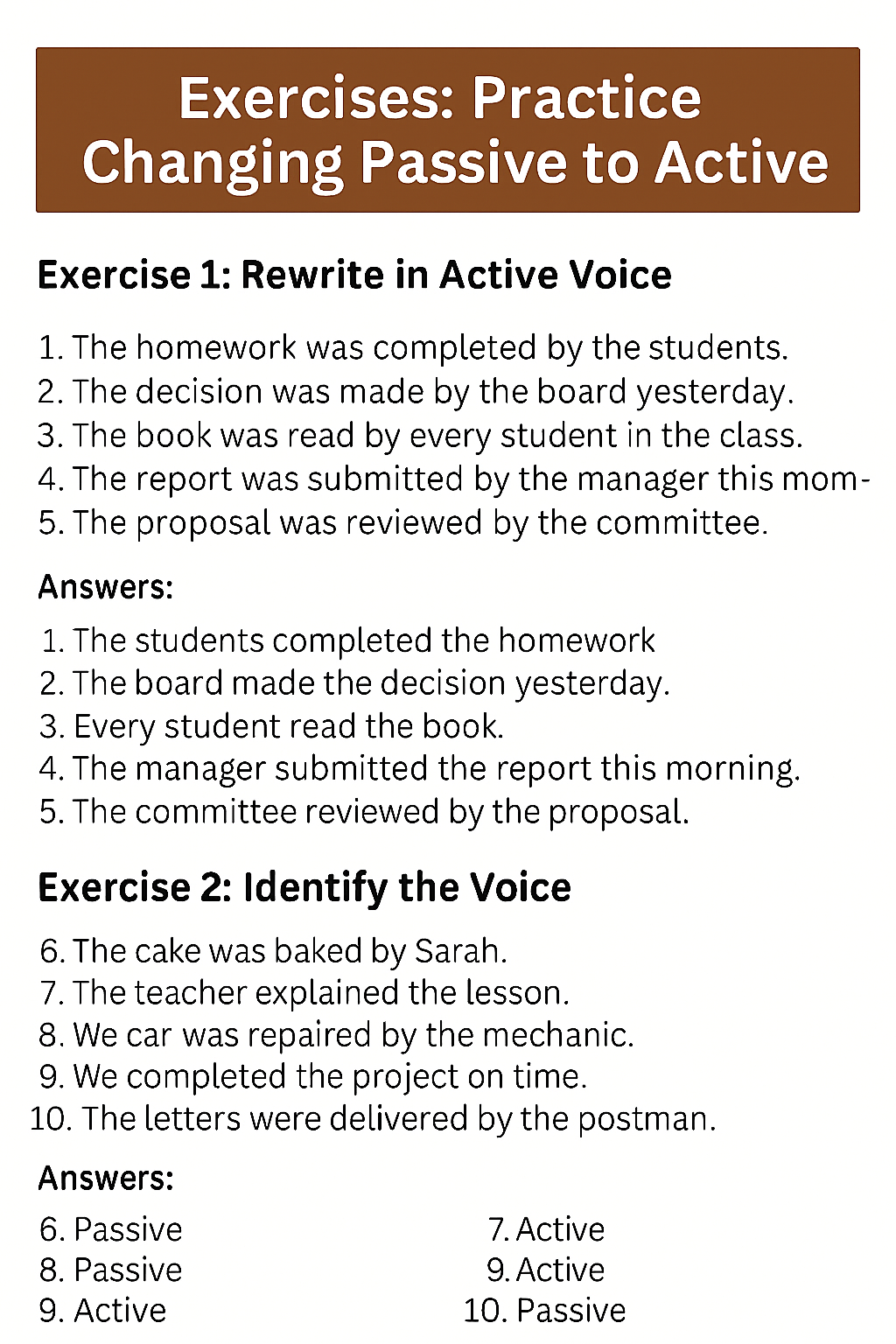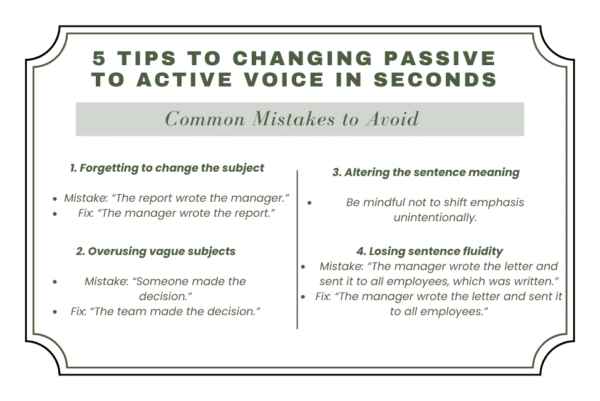Clear and engaging writing often depends on the voice you choose. Many learners struggle with passive constructions that make sentences longer and less direct. To write effectively, it’s important to understand the differences between active vs passive voice and know How to Change Passive to Active Voice. Active voice creates stronger, more dynamic sentences that hold the reader’s attention, while passive voice can sometimes make writing sound distant or confusing. In this guide, you’ll learn when and how to make the shift so your writing becomes more effective and impactful.
What Is Active and Passive Voice?
Before diving into the conversion process, it’s important to define the two voices:
Active Voice: In active voice, the subject of the sentence performs the action. It is typically more direct and clearer to the reader.
- Example: “The dog chased the ball.”
Passive Voice: In passive voice, the subject of the sentence receives the action. The focus is on the action itself or the recipient of the action rather than the doer.
- Example: “The ball was chased by the dog.”
Differences Between Active and Passive Voice
| Active Voice | Passive Voice |
| The subject does the action. | The subject receives the action. |
| The sentence is more straightforward. | The sentence may seem indirect. |
| Often uses fewer words. | Can result in longer sentences. |
| Common in clear, engaging writing. | Often used in formal contexts. |
Why Switch from Passive to Active Voice?
Switching to active voice often makes writing clearer and more engaging. It highlights the subject performing the action, making the message more concise and easier to follow especially important in online or fast-paced reading contexts.
When Should You Use Passive Voice?
While active voice is typically preferred, passive voice is useful in the following situations:
- When the doer is unknown: “The package was delivered.”
- In scientific or formal writing: “The data was analyzed.”
- To emphasize the action or result: “The law was passed unanimously.”
How to Change Passive to Active Voice
Follow these steps:
1. Identify the subject, verb, and object.
- Passive: “The car was cleaned yesterday.”
- Active: “Someone cleaned the car yesterday.”
2. Move the subject (doer) to the beginning.
- Passive: “The letter was sent by Mary.”
- Active: “Mary sent the letter.”
3. Use the correct verb tense.
- Passive: “The car was cleaned yesterday.”
- Active: “Someone cleaned the car yesterday.”
4. Adjust for clarity and grammar.
- Passive: “The project was completed by the team.”
- Active: “The team completed the project.”
Tip: If the doer is unknown, use a general subject like “someone” or “they” as needed.
Common Mistakes to Avoid
1. Forgetting to change the subject
- Mistake: “The report wrote the manager.”
- Fix: “The manager wrote the report.”
2. Overusing vague subjects
- Mistake: “Someone made the decision.”
- Fix: “The team made the decision.”
3. Altering the sentence meaning
- Be mindful not to shift emphasis unintentionally.
4. Losing sentence fluidity
- Mistake: “The manager wrote the letter and sent it to all employees, which was written.”
- Fix: “The manager wrote the letter and sent it to all employees.”
Advantages of Active Voice
- Clarity: The director led the meeting.
- Engagement: The team solved the problem.
- Impact: The committee agreed on the solution.
- Conciseness: Everyone read the book.
When Passive Voice Is Appropriate
- Emphasizing the action: The experiment was conducted.
- Doer is unknown/irrelevant: The letter was sent yesterday.
- Formal tone: The issue was resolved in the meeting.
Exercises: Practice Changing Passive to Active

Exercise 1: Rewrite in Active Voice
- The homework was completed by the students.
- The decision was made by the board yesterday.
- The book was read by every student in the class.
- The report was submitted by the manager this morning.
- The proposal was reviewed by the committee.
Answers:
- The students completed the homework.
- The board made the decision yesterday.
- Every student read the book.
- The manager submitted the report this morning.
- The committee reviewed the proposal.
Exercise 2: Identify the Voice
- The cake was baked by Sarah.
- The teacher explained the lesson.
- The car was repaired by the mechanic.
- We completed the project on time.
- The letters were delivered by the postman.
Answers:
- Passive
- Active
- Passive
- Active
- Passive
Exercise 3: Create Active Voice Sentences
- (The dog, chase)
- (The team, finish)
- (The artist, paint)
- (The manager, oversee)
- (The teacher, prepare)
Answers:
- The dog chased the ball.
- The team finished the game.
- The artist painted a beautiful portrait.
- The manager oversaw the project.
- The teacher prepared the lesson plan.
Conclusion
Mastering How to Change Passive to Active Voice is one of the most effective ways to improve clarity and engagement in your writing. Active voice makes sentences stronger, sharper, and easier to understand, while passive voice is best reserved for specific contexts. To strengthen your skills even further, make reading a daily habit especially newspapers. The benefits of reading newspaper include exposure to clear sentence structures, a wider vocabulary, and real examples of active voice in action. Keep practicing, keep reading, and you’ll soon write with more confidence, energy, and impact.
FAQs: Changing Passive to Active Voice
1. How do you change passive to active voice?
Identify the subject, verb, and object. Rearrange so the subject performs the action, and match the verb tense.
2. What is an example of passive vs. active voice?
Passive: “The lesson was explained by the teacher.”
Active: “The teacher explained the lesson.”
3. What are examples of passive voice?
The homework was completed by the students.
The car was repaired by the mechanic.
The email was sent by the manager.







